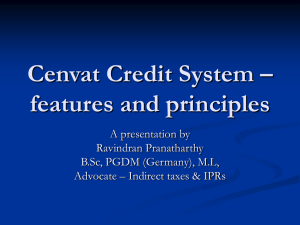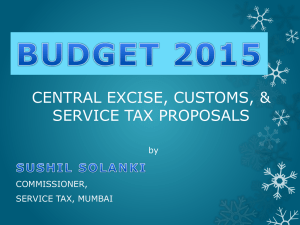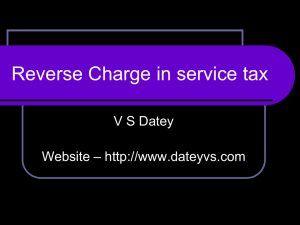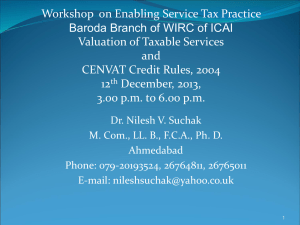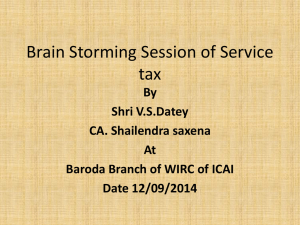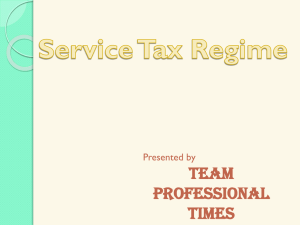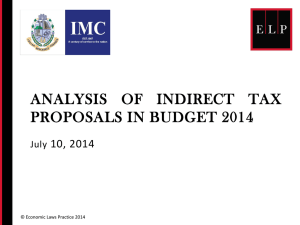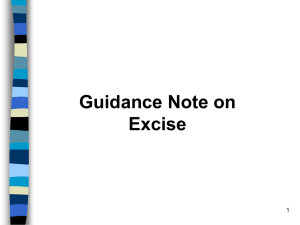cenvat credit – rule 6 - dehradun
advertisement
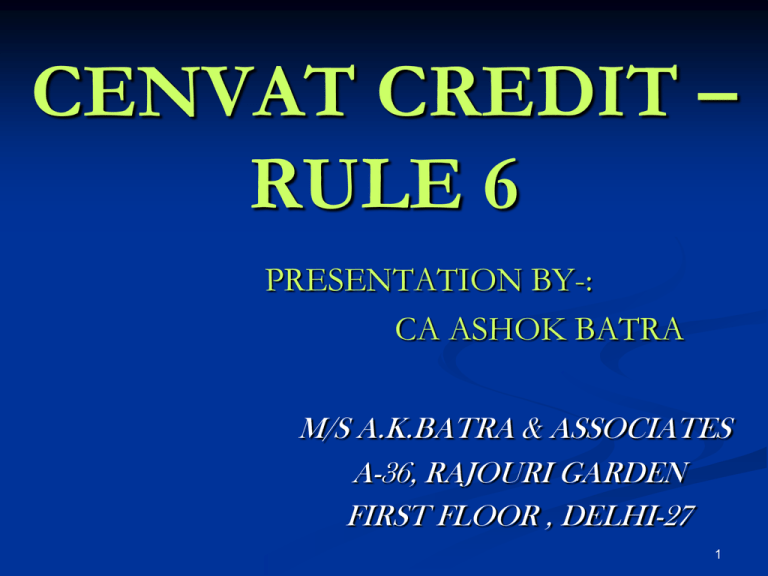
CENVAT CREDIT – RULE 6 PRESENTATION BY-: CA ASHOK BATRA M/S A.K.BATRA & ASSOCIATES A-36, RAJOURI GARDEN FIRST FLOOR , DELHI-27 1 CENVAT CREDIT In any Indirect Tax under VAT system one has to calculate Net Tax payable i.e. Output Tax Liability – Tax Credit Calculation of Output Tax Liability is becoming easier and easier with the increase in the scope of taxable services Money saved is money earned, hence calculation of Tax Credit is gaining importance and will become more relevant in GST regime. 2 CENVAT CREDIT Claim of CENVAT is becoming a subject matter of litigation because: Definition of Inputs, Input services and Capital goods not drafted with precision and subject to interpretation in more than one manner There are economic activities carried out in various permutations and combinations which have not been visualized and provided in law i.e. trading, manufacturing, provision of services and return on investments etc. Difficult to maintain separate records being intangible in nature 3 CENVAT CREDIT Implication of wrong availment of CENVAT: Implication of non-availment of CENVAT Interest, penalties, loss of expense/depreciation resulting into increased liability of Income Tax Increased liability of tax to extent of 70% of CENVAT Cautious and Judicious approach is the answer to the issue 4 CENVAT CREDIT Basic Fundamental: Must fall under the definition of inputs(2k), input services2(l) and capital goods2(a) Must be used for the provision of output service Inputs, services used exclusively for providing exempted service CENVAT not allowed Credit of duty on capital goods and specified services under rule 6(5) shall be allowed even if used partially for providing taxable services There should be a proper duty paying document (invoice, bill, etc.) in terms of Rule 9. 5 CENVAT CREDIT- RULE 6 Obligation of manufacture of dutiable and exempted goods and provider of taxable and exempted services – Not applicable in case of following: 1. Assessee providing only taxable services 2. Assessee providing exempted services only New Procedure applicable w.e.f. 01.04.2008. Prior to that, utilization of CENVAT Credit was restricted to 20% of Output Service tax liability. Accumulated CENVAT Credit as on 01.04.08 shall be available fully as per Departmental clarification F.NO. 137/72/2008-CX.4 dated 21.11.2008. Rule 6 not applicable to services rendered to J&K as these are not exempted services. 6 CENVAT CREDIT – RULE 6 Rule 6(1) No Cenvat credit of Service Tax paid in respect of input or input services used for manufacture of exempted goods or provision of exempted services. Exception - Rule 6 (2) i.e. maintenance of separate records Proviso: CENVAT Credit on inputs shall not be denied to a job worker referred in Rule 12AA of CER, 2002, on the ground that said inputs are used in the manufacture of goods cleared without payment of duty under the provisions of that rule – Applicable in the case of mfr. Under excise 7 CENVAT CREDIT – RULE 6 Situation I – Where service provider is maintaining separate accounts Rule 6(2) – Separate accounts/records Rule 6(2) of CENVAT Credit Rules, 2004, provides that, where a provider of output service avails of CENVAT credit in respect of any inputs or input services and provider of such output service which are chargeable to tax as well as exempted services, then, the provider of output service shall maintain separate accounts for receipt, consumption and inventory of input and input service meant for use in providing output service and the quantity of input meant for use in the exempted services and take CENVAT credit only on that quantity of input or input service which is intended for use in providing output service on which service tax is payable. 8 CENVAT CREDIT – RULE 6 Situation II – Where service provider is not maintaining separate accounts Rule 6(3) and (3A) W.e.f. 01.04.2008, Rule 6(3) is being amended and Rule 6(3A) is being inserted in CENVAT Credit Rules, 2004. Rule 6(3) provides the following options to provider of output service opting not to maintain separate accounts [Rule 6(3)]: Option-I: The provider of output service shall pay an amount equal to 6% (8% upto 07.07.2009)of the value of the exempted services. Manufacture of goods shall pay an amount equal to 5% (10% upto 07.07.2009 of the value of exempted goods Option-II: Provider of taxable services shall reverse the credit attributable to the inputs and input services used for providing exempted services as per the procedure prescribed in the rule i.e. [Rule 6(3A)]. Note: It is an option and not an obligation. Department cannot force the assessee for exercising of a particular option. 9 CENVAT CREDIT – RULE 6 Rule 6(3) and (3A) – Cont. Procedure to be followed for exercising option II Step1: Information to jurisdictional Superintendent before opting for this Scheme While exercising the option of availing CENVAT on provisional (estimated) basis, the provider of output service shall file a letter with the jurisdictional Superintendent containing following information, namely:(i) name, address and registration No. of the provider of output service (i.e. assessee); (ii) date from which the option under this clause is exercised or proposed to be exercised; 10 CENVAT CREDIT – RULE 6 Rule 6(3) and (3A) – Cont. (iii) description of taxable services; (iv) description of exempted services provided and/or to be provided by assessee; (v) opening balance of CENVAT credit of inputs and input services on the date of exercising this option; Option once exercised shall not be reversed during the remaining part of the financial year and to be applied to the business as a whole on the basis of registration 11 CENVAT CREDIT – RULE 6 Rule 6(3) and (3A) – Cont. Step 2 : Provisional CENVAT Credit to be taken by assessee on monthly basis Assessee shall calculate the eligible amount of monthly CENVAT Credit in respect of inputs and input services and avail the same on provisional basis in the ratio of value of taxable and exempted services provided by assessee in the preceding financial year. Assessee shall avail such provisional credit (estimated credit) while discharging its monthly service tax liability 12 CLAIM OF CENVAT Rule 6(3) and (3A) – Cont. Step 3: Calculation of ‘Total Estimated CENVAT Credit’ availed by assessee during the year and ‘Total Actual Admissible CENVAT Credit’ during the year. At the end of financial year, assessee shall calculate the “Total Actual admissible credit” and “Total Estimated Credit”. Total Estimated Credit =“Estimated credit on inputs” plus “Estimated credit on input services” (claimed during the relevant financial year) Total Actual admissible Credit = Total Actual admissible Credit on inputs + Total Actual admissible Credit on input services 13 CLAIM OF CENVAT Rule 6(3) and (3A) – Cont. Step 4: Adjustment/payment of excess/short CENVAT Credit availed by assessee At the end of Financial Year, assessee shall pay the CENVAT Credit on or before 30th June of succeeding financial year if total estimated credit taken by him is MORE than total actual admissible credit admissible. Interest @ 24% per annum shall be charged and collected from such assessee if such service provider makes payment of differential Cenvat after the due date i.e. 30th June. 14 CENVAT CREDIT – RULE 6 Rule 6(3) and (3A) – Cont. Step 5: Information to jurisdictional Superintendent after making aforesaid payment/adjustment The provider of output service shall inform to the jurisdictional Superintendent of Central Excise within a period of 15 days from the date of additional payment or adjustment as explained in step 4 (para no. 2.6) above. Information given by the provider of output service shall contain the following particulars, namely:(i) details of CENVAT credit attributable to exempted goods and exempted services, month wise, for the whole financial year, determined provisionally as calculated 2 & 3 above. (ii) CENVAT credit attributable to exempted goods and exempted services for the whole financial year, determined as per step 3 above. 15 CENVAT CREDIT – RULE 6 Rule 6(3) and (3A) – Cont. (iii) amount short paid determined as per step 4, along with the date of payment of the amount short-paid, (iv) interest payable and paid, if any, on the amount short-paid, if payment is made after 30th June of succeeding financial year. (v) adjustment of CENVAT Credit if assessee had claimed the less CENVAT Credit on estimated basis. 16 Summary of Rule 6 (1), (2) & (3) Sl. Situation No . Extent of CENVAT Credit allowed 1 100% CENVAT Credit is allowed 2 If a service provider / manufacturer provides only taxable services / manufacture only taxable goods If a service provider provides/manufacturer only exempted services / manufacturer only exempted goods No CENVAT Credit is allowed 17 Summary of Rule 6 (1), (2) & (3) Sl. No. Situation 3 If a service provider/manufacturer provides / manufactures both taxable & exempted services: / goods- In this situation following options are available:- Extent of CENVAT Credit allowed (A)Option to maintain separate accounts for the Receipt & Consumption of taxable & non-taxable services/goods vide Rule 6(2) of CENVAT Credit Rule CENVAT Credit allowed only to the extent of inputs/services used in providing taxable services/ taxable goods (B)Option of not to maintain separate accounts in the aforesaid manner(Rule 6(3)(i) OR 6(3) (ii) as the case may be) (i) Either pay 6% (8% upto 6-72009) on the value of exempted services OR (ii) Reverse the CENVAT Credit attributable to the inputs & input services used for providing exempted services/exempted goods 18 Issued involved in applying the formula under Rule 6 (3) Treatment of Traded Goods To be considered on the same footing as that of exempted goods / services Metro Shoes Pvt. Ltd. Vs. CCE Mumbai – 2008 (10) STR 382 (Tri-Mum.) - Cenvat for service tax paid on services which are directly and wholly attributable to the trading activities is not available 19 Issued involved in applying the formula under Rule 6 (3) Whether value of export goods/services should be taken as final product / taxable service or exempted goods / services In respect of exempted services Export of services chargeable to Nil rate of Service Tax Rule of CCR, 2004 – No reversal of Cenvat Credit on exported services. Para 6 of Circular No. 868/6/2008-CX dated 9-5-2008 confirms that export of services without payment of Service Tax are to be treated as taxable services. Value of export of services should be taken in denominator i.e. with the value of taxable services. 20 CENVAT CREDIT – RULE 6 Rule 6 (4) Rule 6(4) of CENVAT Credit Rules, 2004, provides that CENVAT Credit shall not be allowed on capital goods which are used exclusively in the manufacture of exempted goods or in providing exempted services, other than the final product which are exempt from the whole of the duty of excise leviable thereon under any notification where exemption is granted based upon the value or quantity of clearances made in the financial year. NOTE: CENVAT Credit on capital goods will be available to output service provider even if such capital goods are used partly for the purpose of providing taxable service and partly for the purpose of exempted services 21 CENVAT CREDIT – RULE 6 Rule 6(5) Rule 6(5) of Cenvat Credit Rules, 2004, implies that in case of 16 specified services, CENVAT Credit shall not be allowed if such services are used exclusively for providing exempted services. This implies that in case of 16 specified taxable services, service provider can avail full CENVAT credit even if these are partially used in providing output taxable services and partially in providing exempted services. 22 CENVAT CREDIT – RULE 6 Rule 6(5) Following are list of aforesaid services mentioned in Rule 6 (5) • Consulting Engineer • Architect • Interior Decorator • Management, Maintenance or Repair • Foreign Exchange broker other than Banking & Financial Institution with NBFC & Body Corporate • Intellectual property service other than copy right • Management Consultant 23 Cenvat Credit Rule 6(5) • • • • • • • • Real Estate Agent Security Agency Technical Testing and Analysis Scientific or Technical Consultancy Banking & Other Financial Services Erection, Commissioning or Installation Technical Inspection or Certification Construction services in respect of Commercial or Industrial Buildings or Civil Structures 24 CENVAT Credit Rule 6(6) The provisions of sub-rules (1), (2), (3) and (4), shall not be applicable in case the excisable goods removed without payment of the duty under specified circumstances as specified under the law. 25 Clarification by Department w.r.t. Rule 6 Circular No. 868/6/2008-CX dated 09.05.2008 Question 1 : Whether an assessee availing option (i) or option (ii) under rule 6(3) is allowed to take CENVAT Credit of duty paid on inputs and input services which are used for both dutiable and exempted goods or services. Answer: Yes 26 Clarification by Department w.r.t. Rule 6 Circular No. 868/6/2008-CX dated 09.05.2008 Question 2 : Whether an assessee availing option (i) in respect of certain exempted goods/services can also avail option (ii) in respect of other exempted goods or services simultaneously? Answer: No The same assessee cannot avail both option (i) and option (ii) simultaneously during a financial year Option once exercised during a financial year (F.Y.) cannot be withdrawn during the remaining part of the FY 27 Clarification by Department w.r.t. Rule 6 Circular No. 868/6/2008-CX dated 09.05.2008 Question 3 : Assessee opting for option (i) is required to pay an amount equivalent to 10% of value of exempted goods or 8% of value of exempted services. What is the scope of term "value" for the said purpose Answer: Value of exempted goods = As per Section 4/4A of CEA, 1994 (Transaction Value u/s 4 in case goods chargeable to specific rate of duty) Value of exempted services = Gross amount charged for providing exempted service (without abatement) 28 Clarification by Department w.r.t. Rule 6 Circular No. 868/6/2008-CX dated 09.05.2008 Question 4 : What is the accounting code to be followed by the assessee who is required to pay 8% or other amount for the exempted service under Rule 6(3). Answer: 0044 29 Clarification by Department w.r.t. Rule 6 Circular No. 868/6/2008-CX dated 09.05.2008 Question 5 : Whether input services distributor can also opt for option (i) or option (ii)? Answer : No ISD is like a trader. 30 Clarification by Department w.r.t. Rule 6 Circular No. 868/6/2008-CX dated 09.05.2008 Question 6 : Whether export of service without payment of service tax under Export of Service Rules shall be treated as exempted service for the purpose of rule 6(3)? Answer : No 31 Clarification by Department w.r.t. Rule 6 Circular No. 868/6/2008-CX dated 09.05.2008 Question 7 : What is the manner for calculation of CENVAT Credit amount attributable to inputs used in or in relation to the manufacture of exempted goods? Answer : On the basis of actual consumption of inputs used Quantification may be made based upon the stores/production records maintained by the manufacturer Certificate from Cost Accountant/Chartered Accountant giving details of quantity of inputs used in the manufacture of exempted goods, value thereof and CENVAT credit taken on these input may be submitted at the end of the year. 32 Clarification by Department w.r.t. Rule 6 Circular No. 868/6/2008-CX dated 09.05.2008 Question 8 : Whether credit in respect of input services covered by rule 6(5) would be required to be taken into account for determination of amount payable as per formula provide in rule 6(3A). Answer : No 33 Rule 6 not applicable to services rendered to J&K as these are not exempted services. Services provided to establishment located in J&K shall not be considered as exempted service. ECIL Rapicscan Ltd. V Commissioner of Service Tax, Hyderabad-2010(17) S.T.R. 433 (Tri.-Bang) Appellant providing services to various establishment in the Country including establishment located in J&K. Held J&K region falls outside the purview of Chapter V of Finance Act 1994 Cenvat Credit Rules shall not be applicable in such case. 34 CENVAT Credit Is Indefeasible Vijayanand Roadlines v. CCE, Belgaum, 2007 (7) STR 219 (Tri-Bang) CENVAT Credit Rules, 2004 only entails the allowability of Cenvat Credit Does not provide any conditions for its availment or utilization It is at the discretion of the service provider as to at what point of time it intends to avail and utilize the CENVAT credit accumulated with it 35 Important Case Law Credit utilization of 20% not applicable to capital goods Idea Celllular Ltd. Vs CCE Rohtak [2009] 16 STR 712 (Tri-Delhi) If Services becomes taxable during the year CENVAT available proportionately even if falls under Rule 6(5) G.H.C.L Ltd. Vs CCE Bhavnagar[2009] 16 STR 588 36 Important Case Law If exempted service started during the year, full CENVAT credit till exempted service was not provided Mount Mettur Pharmaceuticals Ltd. Vs CCE Chennai [2009] 13 STR 414 Cenvat credit reversal equal to credit not taken 2004 [174] ELT 422 (All) Mount Mettur Pharmaceuticals Ltd. Vs CCE Chennai [2009] 13 STR 414 37 Important Case Law Maintenance of separate accounts initially not a pre-condition for claiming exemption CCE vs. Ashima Dyecot Ltd. [2008] 12 STR 701 (Guj) Rule 6(5) Non-Obstante clause, for claiming 100% CENVAT on specified services, one need not make separate accounts CCE Goa vs V.M.Salgaonkar & Bros. Pvt. Ltd [2008] 10 STR 609 (Tri-Mumbai) 38 Important Case Law Rule 6(5) has used the word ‘allowed’ and it covers both taking and utilization. No reason for allowing credit and not permitting utilisation. CCE Goa vs V.M.Salgaonkar & Bros. Pvt. Ltd [2008] 10 STR 609 (Tri-Mumbai) 39 Important Case Law M/s AVAYA GLOBAL CONNECT LTD Vs CCE, AHMEDABAD, 2010-TIOL-397-CESTAT-AHM Department’s view that even if CENVAT credit on common input services is not taken, appellant is required to maintain separate accounts not proper Unless the department shows that appellants have availed credit of input services which have also been used for providing any of the exempted services, the demand cannot be sustained 40 Important Case Law Very vide meaning has been given to the term ‘Input Services’ under various judgments. Activity in relation to business has also been given very wide meaning. Case laws: ABB, Coco Cola An activity which has got the remotest connection has been held as Input Service. Victor Gaskets India Ltd. [2008] 12 STR 468 (Tribunal Larger Bench) – Outdoor caterer services availed for running canteen in factory premises for employees, CENVAT allowed 41 M/s ABB Ltd. v. CCE, Bangalore, 2009-TIOL-830CESTAT-BANG-Larger Bench (the ABB Case) Scope of definition of ‘input service’ – examined:- “3. The above definition can be conveniently divided into the following five categories, insofar as the manufacturers are concerned: (a) Any service used by the manufacturer, whether directly or indirectly, in or in relation to the manufacture of final products, (b) Any service used by the manufacturer whether directly or indirectly, in or in relation to clearance of final products from the place of removal, (c) Services used in relation to setting up, modernization, renovation or repairs of a factory, or an office relating to such factory, 42 M/s ABB Ltd. v. CCE, Bangalore, 2009-TIOL-830CESTAT-BANG-Larger Bench (the ABB Case) (d) Services used in relation to advertisement or sales promotion, market research, storage upto the place of removal, procurement of inputs, (e) Services used in relation to activities relating to business and outward transportation upto the place of removal. Extensive meaning assigned to the phrase ‘in relation to business’ by relying on OECD guidelines Held, Cenvat credit of outward transportation is eligible. Held that for eligibility of Cenvat Credit, there is no precondition that expense/cost forms part of transaction value/Assessable Value. 43 COCA COLA V. CCE, BOM, 2009-TIOL-449HC-MUM-ST (“THE COCA COLA CASE”) Extensive meaning to the phrase ‘in relation to business’ assigned by ABB Case was upheld. Held, that the basic approach adopted by India is to tax services on the destination cum consumption principle, which is in line with international norms. Therefore, OECD Guidelines can be safely considered. 44 COCA COLA CASE (CONTD.) Upheld the observation of ABB case which held that service tax and excise duty are consumption taxes to be borne by the consumer and, therefore, if credit is denied on transportation service, the levy of service tax on transportation will become a tax on business rather than being a consumption tax. On a limited issue held that since the expense of advertisement forms part of Assessable value, Cenvat credit cannot be denied. 45 THANKS M/S A.K.BATRA & ASSOCIATES A-36, RAJOURI GARDEN FIRST FLOOR , DELHI-27 46
